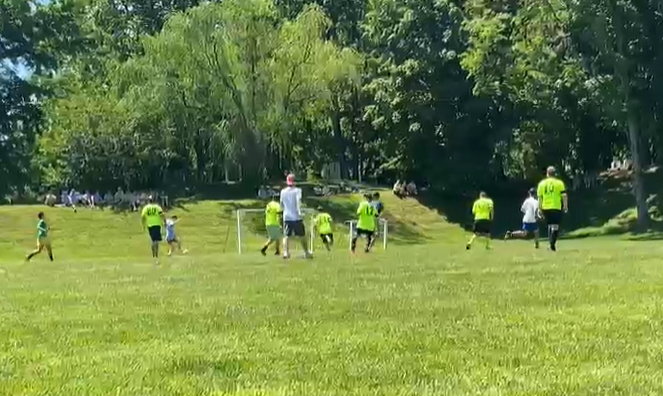One Flew Over the Soccer Match

This year’s annual soccer match between graduates and teachers at the GISW had a small but delightful new feature.
Observers noticed that just above the competitors’ heads small sleek birds darted about, like tiny blue and white jet aircraft performing aerial maneuvers. They were Tree Swallows, newcomers on campus, apparently unafraid of the boisterous activity on the pitch.
The aerial acrobats were there by invitation, residents of a specially designed nest box nearby that was provided by the Science Department as part of its native species restoration project. The concept is to attract Bluebirds, Tree Swallows and other native species that in the past bred on or near the GISW campus; species that directly benefit the ecology of the school community while offering opportunities in field biology – learning their life-cycle, behavior, field marks and interdependence on many other organisms.
In February three specially designed nest boxes were assembled and carefully sited in locations where neither the school’s activities nor the birds’ breeding routines would conflict. This spring all three were occupied. One, on the sodded roof of the Elementary School, a pair of bluebirds have already raised and fledged three chicks. Parents and young may be seen routinely around the school, perched in low tree branches or insect hunting in grass and bushes.
This initiative, as with the pollinator garden project, provides a rewarding element of environmental education where school assignments, classroom teaching and laboratory discovery are enhanced by the excitement of seeing, hearing and studying native species right on campus. For example, 5th and 6th graders learned to calculate the efficiency of swallows’ hunting behavior – the speed of insect capture over the soccer field and return flight to the nest box to feed four rapidly growing hatchlings. Estimates are that each parent makes more than one hundred and twenty hunting-feeding roundtrips per day. Which explains how the little ones are becoming big ones ready to fly the nest by this weekend.
In December, a nest box to accommodate Barred Owls will be erected in a secluded section of the wooded area behind school grounds, not far from the soccer field.
Steffi Colopy
STEM Coordinator









